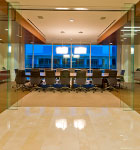1 Evaluate the project
Freeby built his career specializing in what some suspect is a waning skill. Patterned woven carpets—especially those in high-traffic facilities such as casinos and hotels, which Mastercraft Floor Covering deals with often—are notoriously difficult to install.
Before demolishing an old carpet to make way for the new, Mastercraft meets with property owners to determine if there are any specific demands for the space. In the Jefferson Reading Room, for example, only half the room could be worked on at a time. “They wanted to keep it open for the students,” Freeby says.
2 Remove the old carpet
The Mastercraft Floor Covering crew—which, over the course of the nine-day Library of Congress job, included nine installers—removes the existing carpet. It then searches for irregularities in the flooring beneath, and any potential issues are patched.
 3 Put down a pad
3 Put down a pad
Next comes a pad that will sit below the flooring. This pad can vary depending on the type of carpet and how the floor space itself is used. In spaces with high foot traffic, Mastercraft uses a high-density, 26-pound rubber pad.
4 Cut and arrange the new carpet
The installers then perform a sort of dry run, cutting the carpet and arranging it in the space first before gluing it down. The carpet at the Library of Congress was an Axminster with a blend of 80 percent wool and 20 percent nylon. The carpet bears an identical pattern to the Library of Congress’s 1897 original. A pin-dot field of gray is regularly interspersed with a series of ornate circular medallions, and in the center of the room, ten large medallions on a field of unbroken gray each bear an open, wreath-encircled book.
After cutting the pieces of carpet, the seams have to be sealed to prevent fraying. “We’ll use a latex sealer, which is compatible with the carpet,” Freeby says.
5 Set up control lines
Those book medallions—the ones that needed to line up with all ten entrances to the room—are a point of pride for Mastercraft because symmetry isn’t something the original installers, back in the late 19th century, were able achieve. “All the patterns line up now,” Freeby says. “They’re all straight.”
This is mainly the result of meticulous measuring. The carpet installers use masonry lines as guides, stretching them on top of the carpet. Woven carpets are filled with minor variations that make lining up the pattern difficult. “There’s not a piece of patterned carpet out there that’s produced straight,” Freeby says dryly.
The lines, then, are a way of directing where the carpet—which does have some give in its length but not in its width—needs to be stretched. Mastercraft used about 50 lines in the Jefferson Reading Room.
6 Apply adhesive
As the adhesive is applied—a premium, multipurpose adhesive by XL, in the case of the Library of Congress—the carpet is laid one breadth at a time. Once into the glue, “you reset your control lines, and from there you stretch it to the control line to get your pattern straight,” Freeby says. Stay nails keep the carpet in place while the adhesive is still wet.
This work at the Library of Congress was itself complex, but environmental challenges surrounding the project made it even more difficult. Over nine days, Mastercraft’s installers worked through student field trips, a nearly six-point earthquake, and the threat of oncoming Hurricane Irene. To make up for a day lost to an evacuation, the installers worked day and night to finish the job on deadline.
7 Allow the adhesive to cure
The adhesive will take approximately 10 hours to cure, but after that the stay nails can be removed and the carpet walked on freely. If the installation has been done correctly, no bubbles or frayed seams will appear. ABQ




